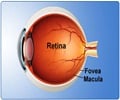Study provides clues as to how the Ebola virus travels to the retina and causes damage.

‘The Ebola retinal scarring pattern supports a theory that the virus travels along neuronal structures within the retina.’





In 2016 an eye team led by Dr Paul Steptoe, compared eye examinations of Ebola survivors in Sierra Leone and a control population. A total of 82 Ebola survivors who had previously reported ocular symptoms and 105 unaffected controls from civilian and military personnel underwent ophthalmic examination, including widefield retinal imaging. The team identified a unique retinal scar in 15% of Ebola survivors who reported eye symptoms after recovering. In the latest study the researchers used a non-invasive imaging test called Optical coherence tomography (OCT) to take pictures of the retinas of the survivors with this Ebola retinal scar. These images provide a high resolution, cross-sectional view of the retina.
These images help demonstrate that within these Ebola retinal scars there are multiple, microscopic focal areas of damage to the retinal layers corresponding to the photoreceptors with a collapse of the overlying retinal structures. This pattern of scarring supports a theory that the virus travels along neuronal structures within the retina.
The researchers also identified areas of abnormal retina surrounding the Ebola retinal scars in 89% of cases. The affected areas appear darker than the normal retina and are due to a change in the reflectance of a layer of the retinal layer called the Ellipsoid zone which contains a high concentration of mitochondria which are the structures that create energy to run the cell.
Dr Paul Steptoe, said: "This is the first time this appearance has been associated with a retinal infection and implies the virus may be causing a wider effect to the surrounding retinal cells beyond the boundary of the scars. Our observations of these areas continue as part of a long-term study Ebola survivors.
Advertisement
"The retina offers a landscape on which to observe and better understand the long-term complications of Ebola virus disease that include ophthalmic and neurological problems."
Advertisement
Source-Eurekalert










